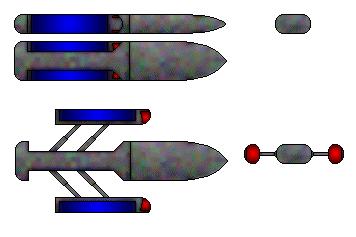 Enhanced Quantum Torpedo (EQT):
Enhanced Quantum Torpedo (EQT):
New Technology:
This system is a variation of an electronic warfare technique developed in the early 21st century. The PIMESS detects active sensing, both electromagnetic and subspace, and immediately narrowcasts a phase-inverted signal of the same type and frequency. The reflected signal and the narrowcast signal are 180 degrees out of phase, and thus cancel each other out.
PIMESS is not particularly useful unless used in conjunction with holographic hull projectors (see first report for details).
 Enhanced Quantum Torpedo (EQT):
Enhanced Quantum Torpedo (EQT):
When Starfleet began experimenting with very small weapons delivery systems, it became apparent that an alternative launching method would be required to equip them with quantum torpedoes. The result was an enhanced version of the quantum torpedo.
The EQT is identical to a standard quantum torpedo, with the addition of 2 meters of additional length. This additional length is a booster module. This booster module includes a quantum flywheel for power and a variable geometry warp propulsion unit with retractable nacelles. Even when launched at sublight velocity, an EQT can accelerate to warp 9.999 or more in only four nanoseconds. The booster module contains additional computing power and sensor capacity necessary to strike a target at ranges of up to 1 standard astronomical unit.
The booster stage of an EQT is designed as a bolt-on enhancement of a standard quantum torpedo, replacing the torpedo's sustainer motor. The diameter of an EQT is identical to that of a standard quantum torpedo. It may be fired from most standard torpedo launchers with simple modifications easily performed at a starbase.
The EQT's design includes a "loiter" mode. In this mode, the EQT acts as a mine. It is deployed at the desired location and remains in "standby" (power conservation) mode. When the on-board sensors detect a pre-programmed target within range, the computer orders the EQT to orient and fire upon the target vessel.
Semi-Autonomous Remotely-Piloted Expendable Vehicle (SARPEV):
During the conflict with the Dominion, Starfleet became aware of the need for small, inexpensive, stealthy vessels for advance scouting and to supplement the role of fighters. The SARPEV is intended to fill this gap.
The SARPEV is designed for two modes of operation. In mode 1, the SARPEV is controlled by an operator aboard the mother ship. In mode two, a low-sentience onboard computer directs the mission according to its programming. The SARPEV is not a disposable asset, like a torpedo. Rather, the SARPEV represents a small-enough investment in resources that it can be used for missions where the risk of loss to a crewed vessel is unacceptably high.
Equipped with a low-sentience onboard computer, the smallest practical warp drive, impulse engine and holographic cloaking device, the SARPEV only has a range of 1-2 days, depending upon power expenditure. The SARPEV is currently expected to perform three primary missions, depending upon the modules installed:
Click
Here to return to VIVA LAS VEGAS main menu
Return
to Top Menu